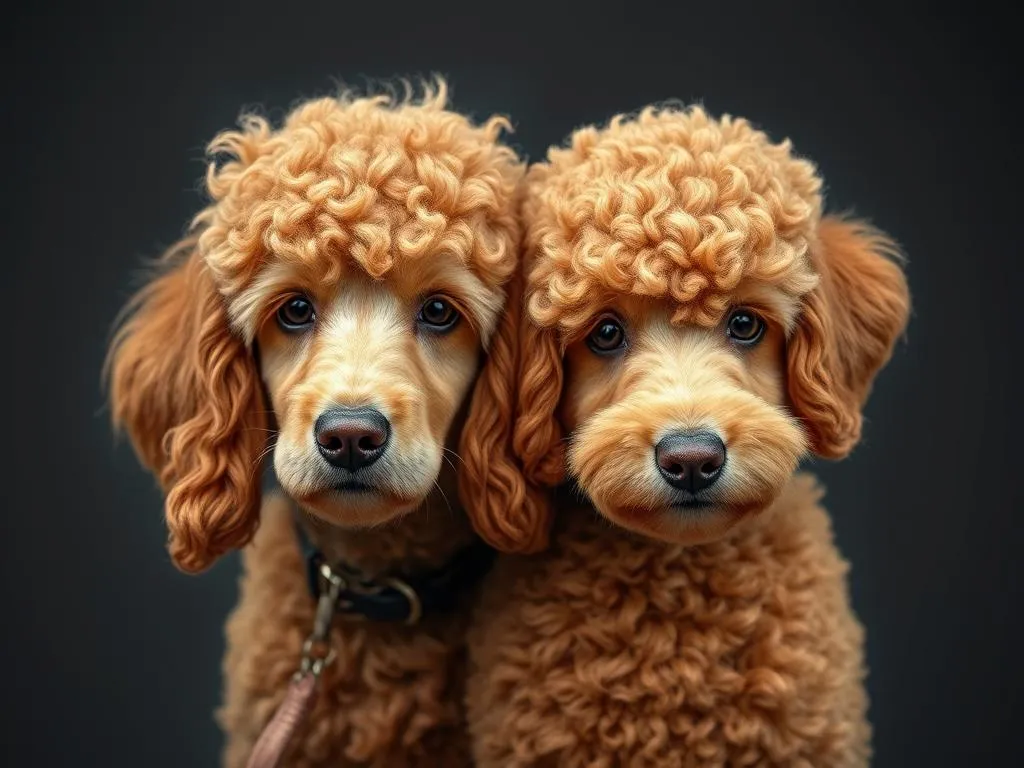
Poodles are one of the most recognized dog breeds worldwide, celebrated not only for their intelligence but also for their elegance and versatility. With a rich history that dates back to their origins in water retrieval, poodles come in three sizes: Standard, Miniature, and Toy. One of the aspects that many prospective poodle owners consider is coat color, which plays a crucial role in breeding and aesthetics. In this article, we will delve into the differences and similarities between red vs apricot poodle, exploring their histories, characteristics, and what sets them apart.
Understanding Poodles
History of the Poodle Breed
The poodle breed has a fascinating history that traces back to Germany, where they were initially developed as water retrievers. The name “poodle” comes from the German word “pudel,” which means “to splash in water.” Over the years, poodles have become popular across Europe, particularly in France, where they were bred for companionship and performance in circuses.
Poodles are classified into three sizes: Standard, Miniature, and Toy. The Standard Poodle is the largest and often used for hunting and sporting, while Miniature and Toy Poodles are primarily kept as companion animals. Regardless of size, all poodles share a common ancestry and exhibit the same intelligence and trainability.
Characteristics of Poodles
Poodles are known for their distinctive curly coats, which are not only aesthetically pleasing but also hypoallergenic, making them suitable for allergy sufferers. Their temperament is generally friendly, intelligent, and eager to please, which makes them highly trainable. However, prospective poodle owners should be aware of common health issues, including hip dysplasia, eye disorders, and skin allergies.
Grooming is essential for maintaining a poodle’s coat. Regular grooming is necessary to prevent matting and to keep their curly fur healthy and clean. Poodle owners should be prepared for a grooming regimen that includes brushing multiple times a week and regular trips to a professional groomer.
The Color Spectrum of Poodles
Importance of Coat Color in Poodles
In the world of poodle breeding, coat color is of significant importance. Different colors can influence a dog’s marketability and breeding potential. Additionally, coat color can be a reflection of genetic diversity within the breed. As breeders select for specific colors, they also consider the overall health and temperament of the dogs.
Overview of Poodle Colors
Poodles come in a variety of colors, including black, white, apricot, red, blue, and more. Among these, red and apricot poodles are particularly popular. The genetics behind poodle colors is complex, with multiple genes influencing the final coat color. Apricot is often considered a lighter shade of red, and the two colors can sometimes overlap in appearance.
Red Poodles
Defining Red Poodles
Red poodles are characterized by their deep, rich coat color, which can vary in shade from a vibrant, true red to a darker mahogany hue. This striking color has gained popularity among dog lovers, making red poodles highly sought after. Their allure often stems from their unique appearance and the rarity of the color.
Historically, red poodles have been part of a breeding program that emphasizes the importance of maintaining the color’s vibrancy and purity. As a result, red poodles are often associated with dedicated breeders who prioritize color integrity and overall health.
Genetic Factors
The genetics behind the red coat is primarily influenced by a recessive gene that causes the fur to exhibit a reddish pigment. Breeders often seek to pair dogs with similar genetic backgrounds to maintain the desired coat color. Visual characteristics that distinguish red poodles include their shiny, vibrant coats and even color distribution throughout their fur.
Common Misconceptions
There are several myths associated with red poodles, primarily revolving around their temperament and health. Some people mistakenly believe that red poodles are more aggressive or hyperactive than other poodles, but this is not necessarily true. The behavior of any poodle, regardless of color, largely depends on training, socialization, and individual personality.
Another misconception involves health implications related to coat color. While some colors may be linked to certain health issues in other breeds, red poodles do not have unique health problems solely based on their coat color. Responsible breeding practices can help minimize health risks.
Apricot Poodles
Defining Apricot Poodles
Apricot poodles are known for their light, warm coat color, which can range from a soft peach to a deeper amber shade. This color is often described as a diluted form of red, making it an attractive choice for many poodle enthusiasts. Like red poodles, apricot poodles have gained popularity due to their unique appearance and friendly disposition.
The popularity of apricot poodles has soared in recent years, with many breeders focusing on this color as part of their breeding programs. This has led to a growing number of apricot poodles available for adoption and purchase.
Genetic Factors
The genetics behind apricot coats are similar to those of red poodles. The color is influenced by specific genes that determine the pigmentation of the fur. Breeders often aim to produce apricot poodles by carefully selecting breeding pairs to achieve the desired shade. Visual characteristics include a soft, warm tone that can vary in intensity across individual dogs.
Common Misconceptions
A common myth surrounding apricot poodles is that they are inherently less healthy or have shorter lifespans than other colors. This is not supported by evidence; health issues in poodles are more closely related to breeding practices than coat color. Responsible breeders focus on the overall health and well-being of their dogs, regardless of color.
Another misconception is that apricot poodles might fade in color as they age. While some dogs may experience slight color changes, many apricot poodles maintain their vibrant hue throughout their lives.
Red vs Apricot: A Comparative Analysis
Physical Differences
When comparing red vs apricot poodle, the most obvious difference is, of course, the coat color. Red poodles exhibit a rich, deep red hue, while apricot poodles showcase a lighter, warmer tone. However, the physical traits of these two colors largely overlap, as both red and apricot poodles share the same breed characteristics, including size and shape.
Temperament and Behavior
Regarding temperament, there is no definitive evidence to suggest that red and apricot poodles behave differently. Both colors exhibit the same friendly, intelligent, and eager-to-please nature that poodles are known for. Anecdotal evidence from poodle owners often points to individual personality rather than color as the determining factor in behavior.
Popularity and Demand
In recent years, both red and apricot poodles have gained popularity among dog owners. However, trends in color preference can vary by region and over time. Red poodles may be in higher demand in certain areas due to their striking appearance, while apricot poodles might appeal to those seeking a softer, warmer color. Adoption rates and market demand can fluctuate, influenced by trends in dog shows and breeding practices.
Choosing Between a Red and Apricot Poodle
Factors to Consider
When deciding between a red vs apricot poodle, prospective owners should consider their lifestyle and personal preferences. While coat color may be a significant factor, it is essential to think about grooming needs, activity levels, and the poodle’s temperament. Allergies should also be taken into account, as both colors have similar hypoallergenic properties.
Long-term Care Considerations
Both red and apricot poodles require regular grooming to maintain their coats. This includes brushing to prevent matting, regular baths, and professional grooming sessions. Health considerations related to color are minimal, but it is crucial for owners to seek out responsible breeders who prioritize the overall health and well-being of their dogs.
Conclusion
In summary, the comparison of red vs apricot poodle highlights both differences and similarities between these two stunning colors. While red poodles are characterized by their vibrant, deep hue, apricot poodles showcase a softer, warm tone. Both colors share the same breed characteristics, temperament, and grooming needs, making them excellent companions for a variety of households.
When choosing between a red and apricot poodle, it’s essential to consider personal preferences, lifestyle, and the commitment to grooming and care. Ultimately, regardless of color, poodles are intelligent, loving, and devoted companions that can enrich the lives of their owners. Responsible breeding and adoption practices should always be prioritized to ensure the health and well-being of these beloved dogs.
FAQs
What is the difference between red and apricot poodles?
The primary difference lies in their coat color. Red poodles have a deep, vibrant red hue, while apricot poodles exhibit a lighter, warmer shade that can range from peach to amber.
Are red or apricot poodles healthier?
Health issues in poodles are more closely related to breeding practices than coat color. Responsible breeders prioritize the overall health of their dogs, regardless of color.
Do red poodles have a different temperament than apricot poodles?
There is no significant difference in temperament between red and apricot poodles. Both colors share the same friendly and intelligent nature typical of the breed.
Which color is more popular, red or apricot poodles?
Popularity can vary by region and over time. Both colors have gained popularity, but trends in preferences can fluctuate based on breeding practices and dog shows.
What grooming needs do red and apricot poodles have?
Both red and apricot poodles require regular grooming to prevent matting and maintain coat health. This includes brushing, bathing, and professional grooming sessions.









